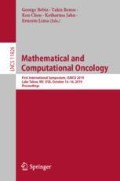Abstract
Gliomas are tumors that evolve from glial cells in the brain or spine. Most gliomas are diagnosed as either lower-grade lesions (grade II) or Glioblastoma (grade IV). Progression of lower-grade gliomas (LGG) to Glioblastoma (GBM) is accompanied by a phenotypic switch to a highly invasive tumor cell phenotype. Converging evidence from different cancer types, including colorectal-, breast-, and lung- cancers, suggests a strong enrichment of high ploidy cells among metastatic lesions as compared to the primary tumor [1, 2]. Even in normal development: trophoblast giant cells - the first cell type to terminally differentiate during embryogenesis - are responsible for invading the placenta and strikingly these cells can have up to 1000 copies of the genome [5]. All this points to the existence of a ubiquitous mechanism that links high DNA content to an invasive phenotype. We formulate a mechanistic Grow-or-go model that postulates higher energy demands of high-ploidy cells as a driver of their invasive behavior. We will test whether this mechanism may contribute to the quick recurrence of GBMs after surgery [7] and whether it can explain striking differences in the prognostic power of integrin signaling and cell cycle progression between males and females [13].
Research reported in this publication was supported by the National Cancer Institute of the National Institutes of Health under Award Number R00CA215256.
Access this chapter
Tax calculation will be finalised at checkout
Purchases are for personal use only
References
Angelova, M., et al.: Evolution of metastases in space and time under immune selection. Cell 175(3), 751–765.e16 (2018). https://doi.org/10.1016/j.cell.2018.09.018. ISSN: 0092-8674, sciencedirect.com/science/article/pii/S0092867418312303. Accessed 15 Mar 2019
Brastianos, P.K., et al.: Genomic characterization of brain metastases reveals branched evolution and potential therapeutic targets. Cancer Discovery 5(11), 1164–1177 (2015). https://doi.org/10.1158/2159-8290.CD-15-0369. ISSN: 2159-8290
Chen, G., et al.: Hsp90 stress potentiates rapid cellular adaptation through induction of aneuploidy. Nature 482(7384), 246–250 (2012). https://doi.org/10.1038/nature10795. ISSN: 1476-4687
Chen, G., et al.: Targeting the adaptability of heterogeneous aneuploids. Cell 160(4), 771–784 (2015). https://doi.org/10.1016/j.cell.2015.01.026. ISSN: 1097-4172
Hannibal, R.L., et al.: Copy number variation is a fundamental aspect of the placental genome. PLoS Genet. 10(5), e1004290 (2014). https://doi.org/10.1371/journal.pgen.1004290. ISSN: 1553-7404
Hastings, P.J., et al.: Mechanisms of change in gene copy number. Nat. Rev. Genet. 10(8), 551–564 (2009). https://doi.org/10.1038/nrg2593. ISSN: 1471-0056, ncbi.nlm.nih.gov/pmc/articles/PMC2864001/. Accessed 15 Aug 2015
Hatzikirou, H., et al.: ‘Go or grow’: the key to the emergence of invasion in tumour progression? Math. Med. Biol. J. IMA 29(1), 49–65 (2012). https://doi.org/10.1093/imammb/dqq011. ISSN:1477-8602
Mroz, E.A., et al.: Intra-tumor genetic heterogeneity and mortality in head and neck cancer: analysis of data from the Cancer Genome Atlas. PLoS Med. 12(2), e1001786 (2015). https://doi.org/10.1371/journal.pmed.1001786. ISSN: 1549-1676
Puchalski, R.B., et al.: An anatomic transcriptional atlas of human glioblastoma. Science 360(6389), 660–663 (2018). https://doi.org/10.1126/science.aaf2666. ISSN: 0036-8075, 1095-9203, science.sciencemag.org/content/360/6389/660. Accessed 15 Mar 2019
Saut, O., et al.: A multilayer grow-or-go model for GBM: effects of invasive cells and anti-angiogenesis on growth. Bull. Math. Biol. 76(9), 2306–2333 (2014). https://doi.org/10.1007/s11538-014-0007-y. ISSN: 1522-9602
Soukup, S.W., Ohno, S.: Evolution by Gene Duplication, p. 160. Springer, New York (1970). Teratology 9(2), 250–251 (1974). ISSN: 1096-9926, https://doi.org/10.1002/tera.1420090224, http://onlinelibrary.wiley.com/doi/10.1002/tera.1420090224/abstract. Accessed 31 Aug 2014
Worrall, J.T., et al.: Non-random mis-segregation of human chromosomes. Cell Rep. 23(11), 3366–3380 (2018). https://doi.org/10.1016/j.celrep.2018.05.047. ISSN: 2211-1247
Yang, W., et al.: Sex differences in GBM revealed by analysis of patient imaging, transcriptome, and survival data. Sci. Trans. Med. 11(473), eaao5253 (2019). https://doi.org/10.1126/scitranslmed.aao5253. ISSN: 1946-6234, 1946-6242, stm.sciencemag.org/content/11/473/eaao5253. Accessed 15 Mar 2019
Author information
Authors and Affiliations
Corresponding author
Editor information
Editors and Affiliations
Rights and permissions
Copyright information
© 2019 Springer Nature Switzerland AG
About this paper
Cite this paper
Kimmel, G., Barnholtz-Sloan, J., Ji, H., Altrock, P., Andor, N. (2019). Modeling the Evolution of Ploidy in a Resource Restricted Environment. In: Bebis, G., Benos, T., Chen, K., Jahn, K., Lima, E. (eds) Mathematical and Computational Oncology. ISMCO 2019. Lecture Notes in Computer Science(), vol 11826. Springer, Cham. https://doi.org/10.1007/978-3-030-35210-3_2
Download citation
DOI: https://doi.org/10.1007/978-3-030-35210-3_2
Published:
Publisher Name: Springer, Cham
Print ISBN: 978-3-030-35209-7
Online ISBN: 978-3-030-35210-3
eBook Packages: Computer ScienceComputer Science (R0)

